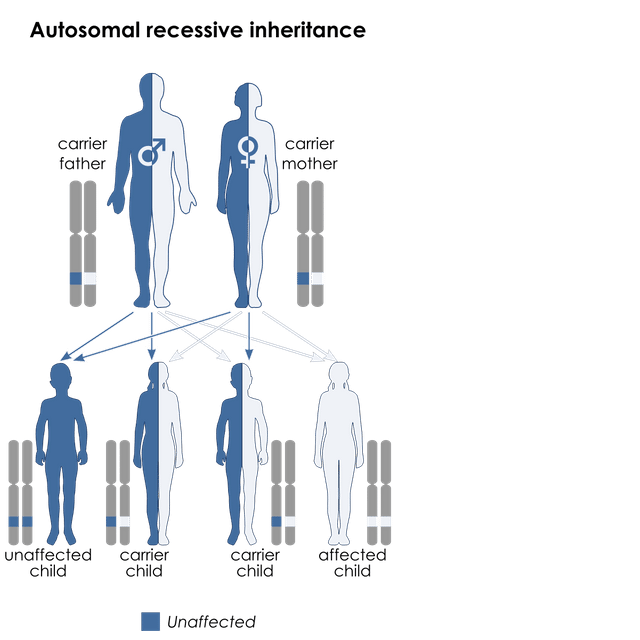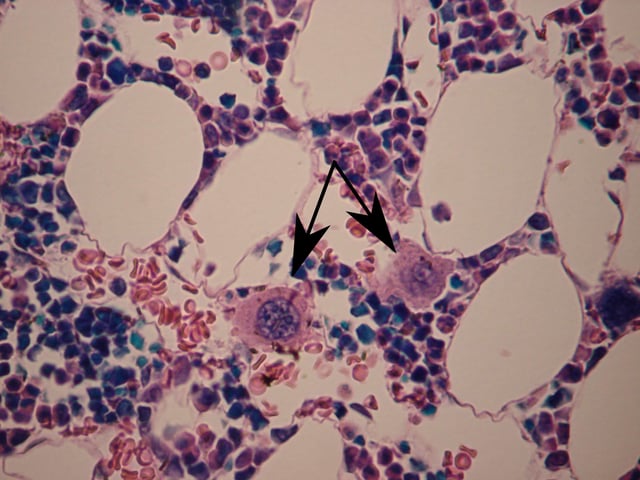Bernard–Soulier syndrome

Bernard–Soulier syndrome

| Bernard-Soulier syndrome | |
|---|---|
| Other names | Hemorrhagiparous thrombocytic dystrophy[1] |
| Bernard-Soulier syndrome has an autosomal recessive pattern of inheritance (rarely autosomal dominant)[2] | |
| Specialty | Hematology |
| Causes | Mutations in GP1BA, GP1BB and GP9[3] |
| Diagnostic method | Flow cytometry analysis[1] |
| Treatment | Platelet transfusion[[4]](https://portal.issn.org/resource/ISSN/"Bernard-Soulier syndrome: an inherited platelet disorder") |
Bernard–Soulier syndrome (BSS), is a rare autosomal recessive bleeding disorder that causes a deficiency of glycoprotein Ib (GpIb), the receptor for von Willebrand factor.[5] The incidence of BSS is estimated to be less than 1 case per million persons, based on cases reported from Europe, North America, and Japan. BSS is a giant platelet disorder, meaning that it is characterized by abnormally large platelets.[6]
| Bernard-Soulier syndrome | |
|---|---|
| Other names | Hemorrhagiparous thrombocytic dystrophy[1] |
| Bernard-Soulier syndrome has an autosomal recessive pattern of inheritance (rarely autosomal dominant)[2] | |
| Specialty | Hematology |
| Causes | Mutations in GP1BA, GP1BB and GP9[3] |
| Diagnostic method | Flow cytometry analysis[1] |
| Treatment | Platelet transfusion[[4]](https://portal.issn.org/resource/ISSN/"Bernard-Soulier syndrome: an inherited platelet disorder") |
Signs and symptoms
Bernard–Soulier syndrome often presents as a bleeding disorder with symptoms of:[7]
Perioperative (and postoperative) bleeding
Bleeding gums
Bruising
Epistaxis (nosebleeds)
Abnormal bleeding (from small injuries)
Unusual menstrual periods
Genetics
In regards to mechanism, there are three genes: GP1BA, GP1BB and GP9 that are involved (due to mutations).[3] These mutations do not allow GPIb-IX-V complex to bind to the von Willebrand factor, which in turn is what would help platelets adhere to a site of injury which eventually helps stop bleeding.[2]
Diagnosis

Megakaryocytes (arrows)
In terms of diagnosis Bernard–Soulier syndrome is characterized by prolonged bleeding time, thrombocytopenia, increased megakaryocytes, and enlarged platelets, Bernard–Soulier syndrome is associated with quantitative or qualitative defects of the platelet glycoprotein complex GPIb/V/IX. The degree of thrombocytopenia may be estimated incorrectly, due to the possibility that when the platelet count is performed with automatic counters, giant platelets may reach the size of red blood cells. The large platelets and low platelet count in BSS are seemingly due to the absence of GPIbα and the filamin A binding site that links the GPIb-IX-V complex to the platelet membrane skeleton.[5][8]
Differential diagnosis
The differential diagnosis for Bernard–Soulier syndrome includes both Glanzmann thrombasthenia and pediatric Von Willebrand disease.[5] BSS platelets do not aggregate to ristocetin, and this defect is not corrected by the addition of normal plasma, distinguishing it from von Willebrand disease.[[4]](https://portal.issn.org/resource/ISSN/"Bernard-Soulier syndrome: an inherited platelet disorder")
Treatment

Tranexamic acid
Bleeding events can be controlled by platelet transfusion. Most heterozygotes, with few exceptions, do not have a bleeding diathesis. BSS presents as a bleeding disorder due to the inability of platelets to bind and aggregate at sites of vascular endothelial injury.[[4]](https://portal.issn.org/resource/ISSN/"Bernard-Soulier syndrome: an inherited platelet disorder") In the event of an individual with mucosal bleeding tranexamic acid can be given.[5]
Prevalence
See also
Gray platelet syndrome
Glanzmann's thrombasthenia
von Willebrand disease
May-Hegglin anomaly